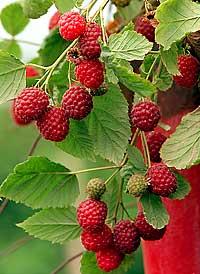Caring for berries

Standing in summer sun, sharing a handful of berries with a friend, can be one of the sweetest and most carefree moments, but come fall, these delicious berries need some care. Cane berries (blackberries and raspberries) and blueberries all have particular end-of-season needs.
They like attention and require just the correct balance of light, water, temperature and pruning technique to thrive. (Yes, I know the escaped Himalayan blackberry needs, apparently, less than nothing at all — but here we're looking at the pedigreed home-gourmet types!)
Blueberries fend for themselves quite well. If they've been more than 3 years in a container, they'd benefit from being set out into open ground. They can outgrow small containers. Enjoy their changing colors: Blueberries qualify as almost-reddest of fall leaves. If your bushes had "mummyberry," a Halloween-sounding affliction, take out all the wizened gray berries clinging to the branches — that will reduce the fungal residue for next season. And mulch under the bushes after leaf fall and again in spring (to keep rain from splashing up more spores). They bear best when 6 to 7 years old, and can go on for 50 years once established.
The beautiful blueberry thrives in acid soil conditions; if yours showed yellowing leaves, or the bushes appear stunted (they can grow to 6 feet), get a soil test to determine pH. If it's over 6.0, blueberries can languish (sulfur applications will reduce the pH). Sawdust makes a fine blueberry mulch.
I was inspired to tackle this thorny (or thornless — some berries are) topic by a man who commented, "I had no fruit on my marionberries — maybe it's because I pruned them to the ground in winter." He was correct. If you're growing any of the "dark" berries, the glossy midnight black of marionberry, or the many thornless types like 'Loch Ness Thornless' or 'Chester Thornless,' pruning is needed now.
For you curious readers who wouldn't consider growing a blackberry, think of the thornless types and recognize that you don't necessarily have to trade your blood for sweet fruit. In addition to being thorny or thornless, blackberries also differ in their needs for support. The tallest and most rambling require supports, keeping the canes off the ground. Some types, like 'Arapaho Thornless,' can be trained into self-supporting 4-foot hedges.
For standard thorny types and marionberries, look at the end-of-season tangles and sort them out now. Blackberries fruit on "primocanes." They emerge during summer, have no fruit, live over the winter and fruit the following summer. A clear-cutting in the cane pasture during winter will set the whole operation back a year. By the end of the fruit season, you'll see a muddle of dying canes that have borne fruit, and fresh green ones with new leaves.
Cut the dead fruited canes to the ground. Tie up the primocanes to a wire support.
Marionberries are winter-hardy down to about 5 degrees Fahrenheit, Cherokee blackberries to about 0. Growers in the coldest areas often lay the primocanes flat on the ground after leaves fall, and cover them with a 4- to 6-inch mulch. (Unbury them in earliest spring to allow new growth.)
Raspberries can be a bit the same, a bit different. They too fruit on straggling canes, but differ in how they're treated in fall depending on how they bear. Once-bearers, that luscious July crop we love for making jam, fruit like the blackberries — they have canes that will be spent from bearing and should be removed in fall. Primocanes will have fresh leaves for next year's crop. ('Meeker' or 'Cascade Delight.')
Confusion sets in with raspberries that are sometimes called ever-bearing, such as 'Summit.' They can bear fruit, not only on the newly emerged canes, but again on those canes that produced in the current summer. Some growers suggest cutting off half of the current fruiting cane, which will bear again next summer along with the new canes. Remove any that have fruited for two years — they've given their all.
If you're inspired to add berries to your garden, check catalogs and nurseries for January planting — I'll be installing some on the safety side of the new deer fence!
Garden expert Mary Robson, retired area horticulture agent for Washington State University/King County Cooperative Extension, shares gardening tips every Wednesday. Her e-mail is marysophia@earthlink.net.